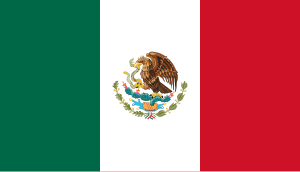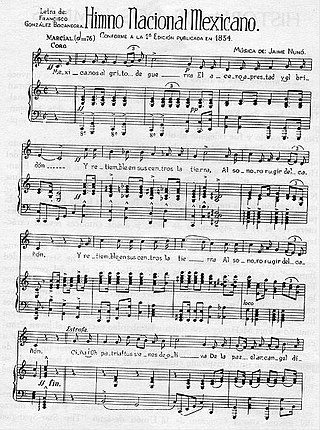
The "Mexican National Anthem", also known by its incipit "Mexicans, at the cry of war", is the national anthem of Mexico. The lyrics of the national anthem, which allude to historical Mexican military victories in the heat of battle and including cries of defending the homeland, were composed by poet Francisco González Bocanegra after a Federal contest in 1853. Later, in 1854, he asked Jaime Nunó to compose the music that now accompanies González's poem. The national anthem, consisting of ten stanzas and a chorus, effectively entered into use on September 16, 1854.

"La Borinqueña" is the official anthem of Puerto Rico.

The national flag of the Argentine Republic, often referred to as the Argentine flag, is a triband, composed of three equally wide horizontal bands coloured light blue and white. There are multiple interpretations on the reasons for those colors. The flag was created by Manuel Belgrano, in line with the creation of the Cockade of Argentina, and was first raised at the city of Rosario on February 27, 1812, during the Argentine War of Independence. The National Flag Memorial was later built on the site. The First Triumvirate did not approve the use of the flag, but the Asamblea del Año XIII allowed the use of the flag as a war flag. It was the Congress of Tucumán which finally designated it as the national flag, in 1816. A yellow Sun of May was added to the center in 1818.

The coat of arms of the Argentine Republic or Argentine shield was established in its current form in 1944 but has its origins in the seal of the General Constituent Assembly of 1813. It is supposed that it was chosen quickly because of the existence of a decree signed on February 22 sealed with the symbol. The first mention of it in a public document dates to March 12 of that same year, in which it is stated that the seal had to be used by the executive power, that is, the second triumvirate. On April 13 the National Assembly coined the new silver and gold coins, each with the seal of the assembly on the reverse, and on April 27 the coat of arms became a national emblem. Although the coat of arms is not currently shown on flags, the Buenos Aires-born military leader Manuel Belgrano ordered to paint it over the flag he gave to the city of San Salvador de Jujuy, and during the Argentine War of Independence most flags had the coat of arms.

The national flag of Panama was made by María de la Ossa de Amador and was officially adopted by the "ley 48 de 1925". The Panamanian flag day is celebrated on November 4, one day after Panamanian separation from Colombia, and is one of a series of holidays celebrated in November known as the Fiestas Patrias.

The current eight-star flag of Venezuela was introduced in 2006. The basic design includes a horizontal tricolour of yellow, blue, and red, dating to the original flag introduced in 1811, in the Venezuelan War of Independence.
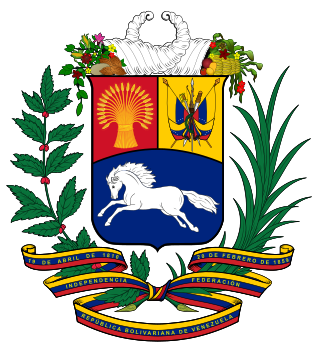
The current coat of arms of Venezuela was primarily approved by the Congress on April 18, 1836, undergoing small modifications through history, reaching the present version.

The banderas monumentales are a collection of tall flagpoles containing large flags of Mexico located throughout Mexico. They are part of a program started in 1999 under President Ernesto Zedillo that is currently administered by the Secretariat of National Defense. The main feature of these monuments is a giant Mexican flag flying off a 50-meter-high (160-ft) flagpole. The size of the flag was 14.3 by 25 metres and it was flown on a pole that measured 50 metres (160 ft) high. In the time after the decree was issued, many more banderas monumentales have been installed throughout the country in various sizes. Many of the locations were chosen due to significant events in Mexican history that occurred there.
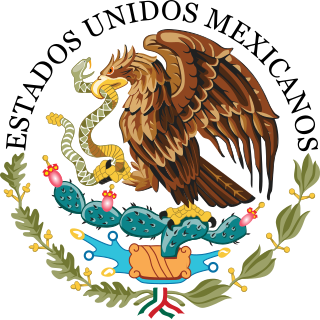
The Law on the National Coat of Arms, Flag and Anthem is a set of rules and guidelines passed by the Mexican government on the display and use of the flag (bandera), coat of arms (escudo) and the anthem (himno). The original law was passed in 1984 and it contains 7 chapters, a preamble and a section that contains the lyrics of the national anthem. The law itself was changed several times, most recently in 2005.

The coat of arms of the Extremadura is described in the Title I of the Spanish Law 4 of June 3, 1985, the Law of the coat of arms, flag and regional day of Extremadura.

The national flag of Mexico is a vertical tricolor of green, white, and red with the national coat of arms charged in the center of the white stripe. While the meaning of the colors has changed over time, these three colors were adopted by Mexico following independence from Spain during the country's War of Independence, and subsequent First Mexican Empire.
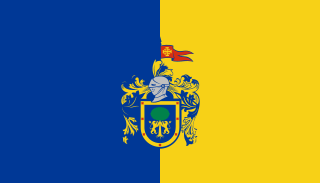
The flag of Jalisco was adopted in 2011. It is colored blue and gold and bears the State Emblem in the center. The emblem has a diameter of three-quarters the width of the stripes. The ratio of the flag is 4:7. Ribbons of the same colors may be placed at the foot of the finial. The flag is one of only three Mexican states that is not simply a coat of arms set against a white background, and it is the only one without any white at all.

The Anthem of Yucatán was officially adopted on September 15, 1867. The lyrics of the state anthem were composed by Manuel Palomeque and the music composed by Jacinto Cuevas. The Anthem of Yucatán was the first state anthem in Mexico. During almost all the 20th century, the anthem was sung in schools.
Most Mexican states do not have an official flag. For these states, a de facto flag is used for civil and state purposes. State flags of Mexico have a 4:7 ratio and typically consist of a white background charged with the state's coat of arms.

The lyrics of the anthem of the Community of Madrid are a poem written by Agustín García Calvo. The music is a work of composer Pablo Sorozábal Serrano. It is the official anthem of the Community of Madrid since 24 December 1983, when it was published in the official regional gazette.

The coat of arms of Buenos Aires Province was declared official on the 19th of October 1935, by Law 4351. It is similar to the arms of Argentina and has its origins in the seal of the General Constituent Assembly of 1813.

The Flag of Baja California Sur is the flag used by the Mexican state of Baja California Sur. The flag was adopted December 31, 2017. The State Flag consists of a white rectangle with a ratio of four to seven between the width and length; in the center it bears the State Coat of arms, placed in such a way that it occupies three-quarters of the width.
